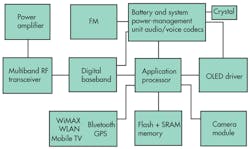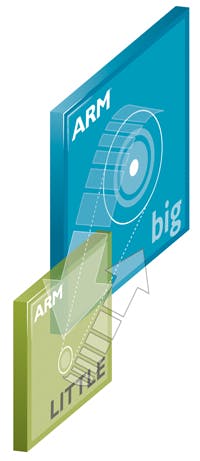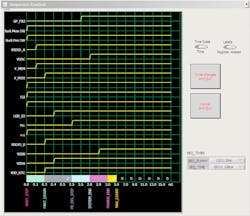The key to maintaining long battery life in a phone is simple to explain—stop it from trying to do too much at once—but harder to achieve in practice. The modern smart phone is a complex mixture of technologies that manufacturers have brought together inside its palm-sized casing, enabling you to know where you are in the world, make calls, surf the Web, send and receive e-mails, and more (Fig. 1).
1. The modern smart phone is a complex mixture of technologies.
The GPS Power Drain
The Global Positioning System (GPS) that many smart phones use to work out your location relies on the phone’s ability to receive and decode precise time signals sent out by orbiting satellites. The decoding process requires a processor inside the phone to work hard to pick out the weak signals from background noise and then compare them with each other repeatedly as you drive along to determine your position on the Earth. The faster you’re traveling, the greater the energy consumption, though this level of work can drain a typical smart phone battery within one to two hours. For longest battery life, simply switch GPS off when it’s not in use.
Wi-Fi Variations
Another major source of power consumption comes from the Wi-Fi interface. The power it needs depends on how strong a signal you can get from the basestation or home router. The strength of that signal depends not only on physical distance but also on the number of signal-absorbing materials in the way, such as walls.
Another factor is the number of other Wi-Fi signals in the area. Getting to your chosen Wi-Fi router through this jungle of signals requires more power, reducing battery life. Switching off Wi-Fi when you’re not using it will significantly extend battery life between charges.
LTE’s High Data Rates
Similar effects come into play when you use the phone for calls or e-mail using the GSM, 3G, or LTE (4G) networks. Your smart phone locks on to one basestation at a time, picking the one that offers the strongest signal, and communicates with it even when your phone is not in use.
Basestations check to see if your phone is within range and switched on so they can direct incoming calls to you. If it is, the phone will reply, “Yes, I’m still here.” This happens only once every 15 minutes or so if your phone is not being used to talk or send data. Users can sometimes hear this happening if the handset is using the network. The signal can induce interference on audio cables that you hear as “chirruping” bursts of noise on the speakers.
There may be occasions when a basestation will be within range but full to capacity with callers. Your phone will then be dynamically directed to another basestation. Accessing this other basestation requires more power because the signal strength is lower, again impacting battery life.
When you’re on the move, you will change basestations many times. Complex communication between outgoing and incoming basestations is needed to “hand over” the call or data connection, which takes more energy. This can happen even if you aren’t moving. In densely populated areas, a single building can receive signals from a number of different basestations. As you move around inside a room, because of the way the radio signal reflects off walls, the signal strength will keep changing, forcing handover to different basestations all the while.
Smart phones now also have short communications with many other services that “push” information out to them. For example, weather apps probably check for new weather information every five or 10 minutes. You may think you haven’t “used” your phone, but actually it has been very busy for you. One way to combat this power drain is to turn off automatic notifications from apps you don’t use much or to disable LTE, 3G, and Wi-Fi communication.
Ration Your Display Backlighting
Smart-phone batteries also seem to drain more quickly than traditional phones because we use their displays more. The backlight for a LCD uses significant power. So, minimize the time your backlight is on.
Meanwhile, the latest organic LED (OLED) displays, which emit their own light, don’t need backlights. As a result, they should be more efficient but the same rule applies: only keep the display on when it is in use.
Power-Savvy Processors
There are two important microprocessors in the smart phone: the baseband processor and the applications processor. The baseband processor deals with the network. The applications processor handles the apps, audio, video, and touchscreen.
The applications processor is growing in importance because apps are the smart phone’s key selling point. There used to be just one microprocessor core in a single applications processor. Now there can be two or more. This proliferation of processor cores, strange as it may seem, will help to keep power consumption down.
ARM’s big.LITTLE architecture combines a small energy-efficient ARM Cortex-A7 and a fast ARM Cortex-A15 for power-hungry tasks (Fig. 2). The more powerful the processor cores and the more cores you use, the higher the peak power. So, the A15 switches off when its hefty horsepower isn’t required, such as when you’re just talking on the phone or writing an e-mail. If you want to play a 3D game, the A15 kicks in because the A7 would not be able to handle it.
2. An ARM big.LITTLE architecture only engages the most powerful (Cortex-A15) core when it’s essential, enabling the exceptionally efficient Corex-A7 core to do most of the work. A quad-core processor can use two of each.
An increasingly important block in the application processor is the graphics processor unit (GPU). It helps draw the user interface and is one of the reasons why smart-phone games are now so fluid and fast. The GPU handles the user interface, fluid dynamics rendering, 3D gaming/navigation, augmented reality, facial feature detection, and gesture recognition.
A CPU like an ARM-Cortex-A7 can perform fixed integer calculations really quickly. GPUs are good at floating-point calculations, but they aren’t as fast as CPUs at fixed integer calculations. Top-end application processors have two GPUs, and processors with four GPUs are in development.
The latest smart-phone designs use two dual cores (two big.LITTLE cores) and quad-core application processors. The development burden is moving into software: how can you split or assign tasks between four cores? This will become more of a challenge when eight-core processors start to appear.
The question is also how many tasks you need to run in parallel. In the future, more tasks will be assigned to the applications processor to create efficient high-end apps such as augmented reality. These new apps with augmented reality, such as lassoing objects found with the phone camera, represent potentially huge leaps forward in app usage. Future application processors probably will include more GPUs and probably two or four CPUs.
Finally, the high peak performance of GPUs comes at a price: power. Again, when it isn’t needed, the GPU can be switched off.
Configurable PMICs Police Power
The key to ensuring that only the blocks that are absolutely needed at any one time are used lies in another component: the power-management integrated circuit (PMIC). It acts as an orchestral conductor for the system, telling blocks when to wake up and when to go to sleep to save energy.
The PMIC is often separate from the baseband and applications processors, which may seem counterintuitive. Traditionally, the semiconductor industry integrates functions and even chips into one new chip. But there is a good reason why the PMIC remains separate.
The PMIC has to generate up to 30 different power supplies to be able to feed different parts of the baseband and applications processor with the right combination of voltage and current. Rather than running at peak speed all of the time, it is possible to save additional energy by providing a lower voltage, which slows down processing.
Because the energy consumed is proportional to the voltage, the energy savings can be significant. But it’s important that each processor or hardware block gets exactly the right voltage. This is why the PMIC needs to be able to generate so many different voltage sources.
The power-up order becomes another important consideration: you can’t switch on all 30 voltages at the same time or in a random order. The application processor will need to have power before the memory is powered up, and the baseband processor will need power before the 3G network is switched on (Fig. 3). You also need to power down units in the right order. And, this sequencing can be happening all the time that the phone is “on.”
3. Dialog’s Power Commander GUI lets you configure the precise power sequencing of any quad-core, dual-core, or single-core applications processor.
Phones have advanced levels of sleep modes, from light sleep to a very deep sleep in which almost everything is switched off. Most of this advanced power management is invisible to the end user. You might notice that it occasionally takes longer than normal to perform a certain operation such as starting your Internet browser.
The PMIC also coordinates charging. Modern phones have lithium-ion (Li-ion) batteries. Unlike the nickel-cadmium or nickel-metal-hydride batteries used in older consumer electronics devices, these batteries do not have a “memory,” which reduces the amount by which you could charge the battery if it wasn’t fully discharged first. So, there is no penalty in frequently recharging a Li-ion battery other than the inconvenience of having to find a wall socket. In fact, charging it more often from a less discharged state improves the total life of the battery.
However, charging a Li-ion battery is completely different from charging something like the lead-acid battery in a car. The Li-ion battery needs very careful and controlled charging even in different modes. The battery charger sits in several locations: the wall wart charger, the charging electronics in your phone that lie inside the PMIC, and inside the battery itself.
The PMIC detects different charging scenarios such as a USB cable, a wall socket, and, in the future, wireless charging. It distributes the power between the battery and the phone electronics. It decides when to change charging modes and when the battery is full so it stops the charging process or slows it to a trickle so the battery isn’t drained if the phone is in use while plugged in.
In conclusion, the PMIC is the phone’s silent power manager, working hard for you to maximise the battery life between charges and to make sure that it receives the right amount of charge when plugged in. But by turning off wasteful apps and modes, you can give it a helping hand.
Charles Limonard joined Dialog in 2012 and is a product marketing manager within the company specialising in power management. He has more than 18 years of experience within the electronics sector and has also held senior roles within NXP and Philips Semiconductor. Now based in the U.K., he has a BSc in electronics from Hogeschool van Utrecht, Holland.
1. The modern smart phone is a complex mixture of technologies.
2. An ARM big.LITTLE architecture only engages the most powerful (Cortex-A15) core when it’s essential, enabling the exceptionally efficient Corex-A7 core to do most of the work. A quad-core processor can use two of each.
3. Dialog’s Power Commander GUI lets you configure the precise power sequencing of any quad-core, dual-core, or single-core applications processor.



